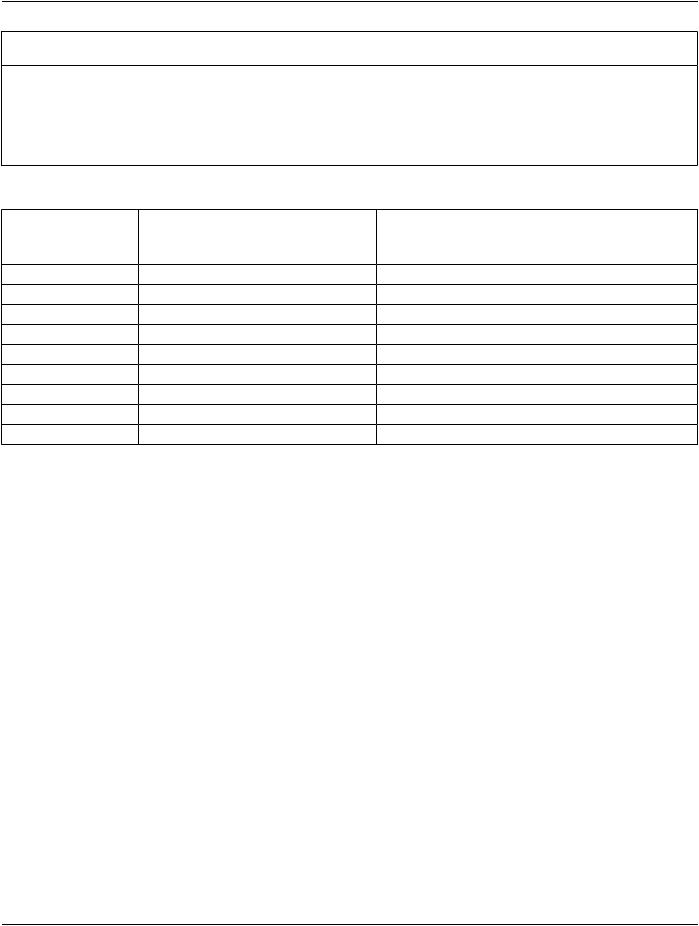
PS-2020a / part17
.pdf
|
DICOM PS3.17 2020a - Explanatory Information |
|
Page 141 |
|
Nest |
Code Meaning of Concept Name |
Code Meaning or |
|
TID |
|
|
Example Value |
|
|
1.9.3 |
Number of follicles in left ovary |
1 |
TID 5013 |
|
1.9.4 |
Follicle Measurement Group |
|
TID 5014 |
|
1.9.4.1 |
Identifier |
#1 |
TID 5014 |
|
1.9.4.2 |
Volume |
3 cm3 |
TID 300 |
|
1.9.4.3 |
Follicle Diameter |
15 mm |
TID 300 |
|
I.8.10 Example 10: Pelvis and Uterus |
|
|
|
|
Nest |
Code Meaning of Concept Name |
CodeMeaningorExample |
TID |
|
|
|
Value |
|
|
1 |
OB-GYN Ultrasound Procedure Report |
|
TID 5000 |
|
1.n |
…. |
|
|
|
1.9 |
Pelvis and Uterus |
|
TID 5015 |
|
1.9.1 |
Uterus |
|
TID 5016 |
|
1.9.1.1 |
Uterus Volume |
136 cm3 |
TID 300 |
|
1.9.1.2 |
Uterus Length |
9.5 cm |
TID 300 |
|
1.9.1.3 |
Uterus Width |
5.9 cm |
TID 300 |
|
1.9.1.4 |
Uterus Height |
4.2 cm |
TID 300 |
|
1.9.2 |
Endometrium Thickness |
4 mm |
TID 5015 |
|
1.9.3 |
Cervix Length |
5.3 cm |
TID 5015 |
|
- Standard -

Page 142 |
DICOM PS3.17 2020a - Explanatory Information |
- Standard -

DICOM PS3.17 2020a - Explanatory Information |
Page 143 |
J Handling of Identifying Parameters (Informative)
ThisAnnexwasformerlylocatedinAnnexM“HandlingofIdentifyingParameters(Informative)”inPS3.4inthe2003andearlierrevisions
of the Standard.
J.1 Purpose of This Annex
TheDICOMStandardwaspublishedin1993andaddressesmedicalimagescommunicationbetweenmedicalmodalities,workstations and other medical devices as well as data exchange between medical devices and the Information System (IS). DICOM defines SOP Instances with Patient, Visit and Study information managed by the Information System and allows to communicate the Attribute values of these objects.
Since the publication of the DICOM Standard great effort has been made to harmonize the Information Model of the DICOM Standard with the models of other relevant standards, especially with the HL7 model and the CEN TC 251 WG3 PT 022 model. The result of these effort is a better understanding of the various practical situations in hospitals and an adaptation of the model to these situations. In the discussion of models, the definition of Information Entities and their Identifying Parameters play a very important role.
The purpose of this Informative Annex is to show which identifying parameters may be included in Image SOP Instances and their related Modality Performed Procedure Step (MPPS) SOP Instance. Different scenarios are elucidated to describe varying levels of integration of the Modality with the Information System, as well as situations in which a connection is temporarily unavailable.
Note
In this Annex, "Image SOP Instance" is used as a collective term for all Composite Image Storage SOP Instances.
The scenarios described here are informative and do not constitute a normative section of the DICOM Standard.
J.2 Integrated Environment
"Integrated" means in this context that the Acquisition Modality is connected to an Information System or Systems that may be an SCP of the Modality Worklist SOP Class or an SCP of the Modality Performed Procedure Step SOP Class or both. In the following description only the behavior of "Modalities" is mentioned, it goes without saying that the IS must conform to the same SOP Classes.
TheModalityreceivesidentifyingparametersbyqueryingtheModalityWorklistSCPandgeneratesotherAttributevaluesduringimage generation. It is desirable that these identifying parameters be included in the Image SOP Instances as well as in the MPPS object in a consistent manner. In the case of a Modality that is integrated but unable to receive or send identifying parameters, e.g., link down, emergency case, the Modality may behave as if it were not integrated.
The Study Instance UID is a crucial Attribute that is used to relate Image SOP Instances (whose Study is identified by their Study In- stance UID), the Modality PPS SOP Instance that contains it as a reference, and the actual or conceptual Requested Procedure (i.e., Study) and related Imaging Service Request in the IS. An IS that manages an actual or conceptual Detached Study Management entity is expected to be able to relate this Study Instance UID to the SOP Instance UID of the Detached Study Management SOP In- stance, whether or not the Study Instance UID is provided by the IS or generated by the modality.
For a detailed description of an integrated environment see the IHE Radiology Technical Framework. This document can be obtained at http://www.ihe.net/
J.2.1 Modality Conforms to Modality Worklist and MPPS SOP Classes
The modality may:
•N-CREATEaMPPSSOPInstanceandincludeitsSOPInstanceUIDintheImageSOPInstanceswithintheReferencedPerformed Procedure Step Sequence Attribute.
•Copy the following Attribute values from the Modality Worklist information into the Image SOP Instances and into the related MPPS SOP Instance:
- Standard -

Page 144 |
DICOM PS3.17 2020a - Explanatory Information |
•Study Instance UID
•Referenced Study Sequence
•Accession Number
•Requested Procedure ID
•Scheduled Procedure Step ID
•Scheduled Procedure Step Description
•Scheduled Protocol Code Sequence
•Create the following Attribute value and include it into the Image SOP Instances and the related MPPS SOP Instance:
•Performed Procedure Step ID
•Include the following Attribute values that may be generated during image acquisition, if supported, into the Image SOP Instances and the related MPPS SOP Instance:
•Performed Procedure Step Start Date
•Performed Procedure Step Start Time
•Performed Procedure Step Description
•Study ID
J.2.2 Modality Conforms Only to The Modality Worklist SOP Class
The modality may:
•In the absence of the ability to N-CREATE a MPPS SOP Instance, generate a MPPS SOP Instance UID and include it into the Referenced Performed Procedure Step Sequence Attribute of the Image SOP Instances. A system that later N-CREATEs a MPPS SOP Instance may use this UID extracted from the related Image SOP Instances.
•Copy the following Attribute values from the Modality Worklist information into the Image SOP Instances:
•Study Instance UID
•Referenced Study Sequence
•Accession Number
•Requested Procedure ID
•Scheduled Procedure Step ID
•Scheduled Procedure Step Description
•Scheduled Protocol Code Sequence
•Create the following Attribute value and include it into the Image SOP Instances:
•Performed Procedure Step ID
A system that later N-CREATEs a MPPS SOP Instance may use this Attribute value extracted from the related Image SOP Instances.
•Include the following Attribute values that may be generated during image acquisition, if supported, into the Image SOP Instances:
•Performed Procedure Step Start Date
•Performed Procedure Step Start Time
- Standard -

DICOM PS3.17 2020a - Explanatory Information |
Page 145 |
•Performed Procedure Step Description
•Study ID
AsystemthatlaterN-CREATEsaMPPSSOPInstancemayusetheseAttributevaluesextractedfromtherelatedImageSOPInstances.
J.2.3 Modality Conforms Only to The MPPS SOP Class
The modality may:
•N-CREATEaMPPSSOPInstanceandincludeitsSOPInstanceUIDintheImageSOPInstanceswithintheReferencedPerformed Procedure Step Sequence Attribute.
•Create the following Attribute values and include them in the Image SOP Instances and the related MPPS SOP Instance:
•Study Instance UID
•Performed Procedure Step ID
•Copy the following Attribute values, if available to the Modality, into the Image SOP Instances and into the related MPPS SOP In- stance:
•Accession Number
•Patient ID
•Patient's Name
•Patient's Birth Date
•Patient's Sex
If sufficient identifying information is included, it will allow the Image SOP Instances and the MPPS SOP Instance to be later related to the Requested Procedure and the actual or conceptual Detached Study Management entity.
•Include the following Attribute values that may be generated during image acquisition, if supported, into the Image SOP Instances and the related MPPS SOP Instance:
•Performed Procedure Step Start Date
•Performed Procedure Step Start Time
•Performed Procedure Step Description
•Study ID
J.3 Non-integrated Environment
"Non-Integrated" means in this context that the Acquisition Modality is not connected to an Information System Systems, does not receiveAttributevaluesfromanSCPoftheModalityWorklistSOPClass,andcannotcreateaPerformedProcedureStepSOPInstance.
The modality may:
•In the absence of the ability to N-CREATE a MPPS SOP Instance, generate a MPPS SOP Instance UID and include it into the Referenced Performed Procedure Step Sequence Attribute of the Image SOP Instances. A system that later N-CREATEs a MPPS SOP Instance may use this UID extracted from the related Image SOP Instances.
•Create the following Attribute values and include them in the Image SOP Instances:
•Study Instance UID
•Performed Procedure Step ID
- Standard -

Page 146 |
DICOM PS3.17 2020a - Explanatory Information |
AsystemthatlaterN-CREATEsaMPPSSOPInstancemayusetheseAttributevaluesextractedfromtherelatedImageSOPInstances. •Copy the following Attribute values, if available to the Modality, into the Image SOP Instances:
•Accession Number •Patient ID •Patient's Name •Patient's Birth Date •Patient's Sex
If sufficient identifying information is be included, it will allow the Image SOP Instances to be later related to the Requested Procedure and the actual or conceptual Detached Study Management entity.
•Include the following Attribute values that may be generated during image acquisition, if supported, into the Image SOP Instances: •Performed Procedure Step Start Date
•Performed Procedure Step Start Time •Performed Procedure Step Description •Study ID
AsystemthatlaterN-CREATEsaMPPSSOPInstancemayusetheseAttributevaluesextractedfromtherelatedImageSOPInstances.
J.4 One MPPS Is Created in Response to Two Or More Requested Procedures
In the MPPS SOP Instance, all the specific Attributes of a Scheduled Procedure Step or Steps are included in the Scheduled Step Attributes Sequence. In the Image SOP Instances, these Attributes may be included in the Request Attributes Sequence. This is an optional Sequence in order not to change the definition of existing SOP Classes by adding new required Attributes or changing the meaning of existing Attributes.
Both Sequences may have more than one Item if more than one Requested Procedure results in a single Performed Procedure Step.
Because of the definitions of existing Attributes in existing Image SOP Classes, the following solutions are a compromise. The first onechoosesorcreatesavalueforthesinglevaluedAttributesStudyInstanceUIDandAccessionNumber.Thesecondonecompletely replicates the Image data with different values for the Attributes Study Instance UID and Accession Number.
J.4.1 Choose Or Create A Value For Study Instance UID and Accession Number
The modality may:
•In the Image SOP Instances:
•create a Request Attributes Sequence containing two or more Items each containing the following Attributes:
•Requested Procedure ID
•Scheduled Procedure Step ID
•Scheduled Procedure Step Description
•Scheduled Protocol Code Sequence
•create a Referenced Study Sequence containing two or more Items sufficient to contain the Study SOP Instance UID values from the Modality Worklist for both Requested Procedures
•select one value from the Modality Worklist or generate a new value for:
- Standard -

DICOM PS3.17 2020a - Explanatory Information |
Page 147 |
•Study Instance UID
•select one value from the Modality Worklist or generate a new value or assign an empty value for:
•Accession Number
•In the MPPS SOP Instance:
•create a Scheduled Step Attributes Sequence containing two or more Items each containing the following Attributes:
•Study Instance UID
•Referenced Study Sequence
•Accession Number
•Requested Procedure ID
•Scheduled Procedure Step ID
•Scheduled Procedure Step Description
•Scheduled Protocol Code Sequence
•include the following Attribute value that may be generated during image acquisition, if supported:
•Procedure Code Sequence
•In both the Image SOP Instances and the MPPS SOP Instance
•create a Performed Procedure Step ID
•include the following Attribute values that may be generated during image acquisition, if supported:
•Performed Procedure Step Start Date
•Performed Procedure Step Start Time
•Performed Procedure Step Description
•Study ID
J.4.2 Replicate The Image IOD
An alternative method is to replicate the entire Image SOP Instance with a new SOP Instance UID, and assign each Image IOD it's own identifying Attributes. In this case, each of the Study Instance UID and the Accession Number values can be used in their own Image SOP Instance.
BothImageSOPInstancesmayreferenceasingleMPPSSOPInstance(viatheMPPSSOPInstanceUIDintheReferencedPerformed
Procedure Step Sequence).
Each individual Image SOP Instance may reference it's own related Study SOP Instance, if it exists (via the Referenced Study Se- quence). This Study SOP Instance has a one to one relationship with the corresponding Requested Procedure.
If an MPPS SOP Instance is created, it may reference both related Study SOP Instances.
The modality may:
•For all Series in the MPPS, replicate the entire Series of Images using new Series Instance UIDs
•Create replicated Image SOP Instances with different SOP Instance UIDs that use the new Series Instance UIDs, for each of the two or more Requested Procedures
•In each of the Image SOP Instances, using values from the corresponding Requested Procedure:
- Standard -

Page 148 |
DICOM PS3.17 2020a - Explanatory Information |
•create a Request Attributes Sequence containing an Item containing the following Attributes: •Requested Procedure ID
•Scheduled Procedure Step ID •Scheduled Procedure Step Description •Scheduled Protocol Code Sequence
•copy from the Modality Worklist: •Study Instance UID •Accession Number
•create a Referenced Study Sequence containing an Item containing the following Attribute: •Study SOP Instance in the Referenced Study Sequence from the Worklist
•In the MPPS SOP Instance (if supported):
•create a Scheduled Step Attributes Sequence containing two or more Items each containing the following Attributes: •Study Instance UID
•Referenced Study Sequence •Accession Number •Requested Procedure ID •Scheduled Procedure Step ID
•Scheduled Procedure Step Description •Scheduled Protocol Code Sequence
•include the following Attribute value that may be generated during image acquisition, if supported: •Procedure Code Sequence
•In both the Image SOP Instances and the MPPS SOP Instance (if supported): •create a Performed Procedure Step ID
•include the following Attribute values that may be generated during image acquisition, if supported: •Performed Procedure Step Start Date
•Performed Procedure Step Start Time •Performed Procedure Step Description •Study ID
J.5 MPPS SOP Instance Created by Another System (not the Modality)
If for some reason the Modality was unable to create the MPPS SOP Instance, another system may wish to perform this service. This system must make sure that the created PPS SOP Instance is consistent with the related Image SOP Instances.
Depending on the availability and correctness of values for the Attributes in the Image SOP Instances, these values may be copied into the MPPS SOP Instance, or they may have to be coerced, e.g., if they are not consistent with corresponding values available from the IS.
- Standard -

DICOM PS3.17 2020a - Explanatory Information |
Page 149 |
Forexample,iftheMPPSSOPInstanceUIDisalreadyavailableintheImageSOPInstance(intheReferencedPerformedProcedure Step Sequence), it may be utilized to N-CREATE the MPPS SOP Instance. If not available, a new MPPS SOP Instance UID may be generatedandusedtoN-CREATEtheMPPSSOPInstance.InthiscasetheremaybenoMPPSSOPInstanceUIDintheReferenced Performed Procedure Step Sequence in the corresponding Image SOP Instances. An update of the Image SOP Instances will restore the consistency, but this is not required.
J.6 Mapping of Study Instance UIDs to the Study SOP Instance UID
Retired. See PS3.17-2004.
- Standard -

Page 150 |
DICOM PS3.17 2020a - Explanatory Information |
- Standard -
